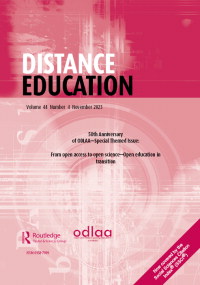Exploring student perceptions of asynchronous video in online courses
IF 3.7
1区 教育学
Q1 EDUCATION & EDUCATIONAL RESEARCH
引用次数: 5
Abstract
Abstract Research suggests that video can improve social presence in online courses. Video, though, is not a panacea; rather the success of video use depends in part on how and when it is used. Online instructors are increasingly using video in various ways, but questions remain on which types of videos students value most when it comes to establishing social presence. Given this, this mixed-methods sequential explanatory study explored student perceptions of three types of asynchronous video: video announcements, instructional videos, and video feedback. The results suggest that while video has the potential to improve social presence, it ultimately depends on both how the video is used in the online classroom as well as students’ individual preferences. Students in this study preferred instructional videos the most, followed by video feedback, and then video announcements. The paper provides implications for future research and practice.探究学生对在线课程中异步视频的看法
摘要研究表明,视频可以提高在线课程中的社交影响力。然而,视频并不是万灵药;相反,视频使用的成功在一定程度上取决于它的使用方式和时间。在线教师越来越多地以各种方式使用视频,但在建立社交影响力时,学生最看重哪种类型的视频仍然是个问题。有鉴于此,这项混合方法的顺序解释研究探讨了学生对三种类型的异步视频的感知:视频公告、教学视频和视频反馈。研究结果表明,虽然视频有可能提高社交影响力,但它最终取决于视频在在线课堂上的使用方式以及学生的个人偏好。本研究中的学生最喜欢教学视频,其次是视频反馈,然后是视频公告。该论文对未来的研究和实践提供了启示。
本文章由计算机程序翻译,如有差异,请以英文原文为准。
求助全文
约1分钟内获得全文
求助全文
来源期刊

Distance Education
EDUCATION & EDUCATIONAL RESEARCH-
CiteScore
10.70
自引率
6.80%
发文量
29
期刊介绍:
Distance Education, a peer-reviewed journal affiliated with the Open and Distance Learning Association of Australia, Inc., is dedicated to publishing research and scholarly content in the realm of open, distance, and flexible education. Focusing on the freedom of learners from constraints in time, pace, and place of study, the journal has been a pioneering source in these educational domains. It continues to contribute original and scholarly work, playing a crucial role in advancing knowledge and practice in open and distance learning.
 求助内容:
求助内容: 应助结果提醒方式:
应助结果提醒方式:


